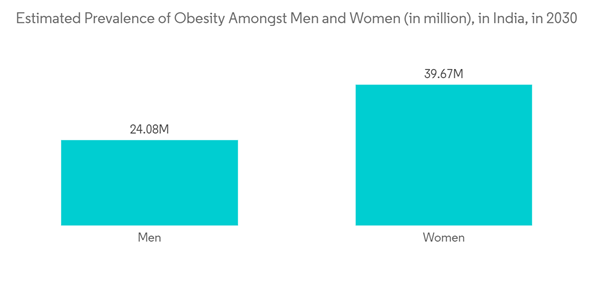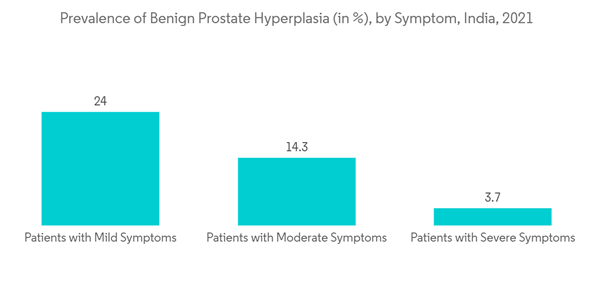Key Highlights
- The healthcare system witnessed enormous challenges due to the COVID-19 pandemic. All outpatient treatments were postponed or restricted during the COVID-19 pandemic to reduce the risk of viral transmission, as most chronic therapies were regarded as non-urgent. The restrictions imposed by tthe lockdown in India caused an increase in demand and a slow supply of raw materials for medical device manufacturing, significantly impacting the growth of the urology devices market in India.
- According to the article published in the Archives of Surgery and Clinical Research journal in June 2021, the pandemic significantly impacted urology practice in India, causing different challenges for the urologists working during the pandemic. Additionally, a study published by the National Center for Biotechnology Information (NCBI) in July 2021 stated that during the COVID-19 lockdown, the number of urology patients admitted indoors dropped by 93.86% in Mumbai. Stone disease, hematuria, and malignancy accounted for 53.65%, 15.85%, and 9.75% of indoor admissions. The drop in stone disease patients during the pandemic led to decreased adoption of stone management devices, significantly impacting market growth in the country.
- Therefore, looking at the overall scenario, it was observed that the COVID-19 pandemic had a significant impact on the market studied. However, currently, the market has reached its pre-pandemic nature in terms of the demand for urology products and is expected to witness healthy growth during the forecast period. The factors responsible for the high growth in India's urology device market are the rising burden of urological diseases, surging government initiatives to promote medical device adoption and production, and technological advancements in urology devices.
- The high prevalence of various urinary tract disorders in the country is one of the major factors responsible for high market growth. For instance, as per the article published by The National Medical Journal of India in October 2022, the prevalence of urinary stones was around 4% to 15% among the general population in the country. Thus, India's rising number of urological diseases also adds to the studied market's growth.
- Furthermore, as per an article published by NCBI in December 2021, India was one of the most populous countries and had many people affected by urology diseases. The article indicated that India was one of the three nations that had the highest incidences of urinary tract infections, urolithiasis, and benign prostatic hyperplasia. The high number of urological diseases in India, requiring the need for novel urological devices, is likely to add to the growth of the market in India in the forecast period.
- The government of India has laid several guidelines to restrict the harmful impacts of urological diseases in the nation. An article published by the Indian Journal of Urology in July 2021 discussed the Urological Society of India's benign prostatic hyperplasia/obstruction ((BPH//BPO) guidelines. The guidelines focused on advocating the use of surgical treatment, including laser devices such as green light LASER and Thulium LASER. Such guidelines by the government on the use of urological treatment devices are expected to propel the growth of the urology device market during the forecast period.
- The product innovation by several key players in India is also adding to the market growth. For instance, in June 2022, Austrak, an India-based company, launched its new super specialty division to focus on around 73 valued products in nephrology and urology. The company focuses on the supply of products and services that help diagnose and treat critical illnesses like chronic kidney disease (CKD) and urology-related ailments. Such activities focusing on expanding the urology department in the healthcare sector in India, thereby increasing the demand for urological devices, are promoting market growth in the region.
- However, the high cost of devices coupled with the lack of adequate infrastructure and logistics are likely to restrict the market's growth over the forecast period.
India Urology Device Market Trends
The Stone Management Segment is Expected to Witness a Healthy Growth Rate in the India Urology Device Market.
- The stone management devices segment is expected to witness a significant growth rate in the India Urology devices market during the forecast period. The large number of people affected by kidney stones in the nation is adding to the growth of the stone management devices segment in the urology devices market.
- According to an article published in the Nepal Journal of Epidemiology in March 2021, the co-relationship between the occurrence of urinary stones with age, sex of the patients, their religion, and the site of stones in a specific area in the Uttarakhand on diagnosis was found to be statistically significant. The article indicated that around 15% of the population has been affected by kidney stone problems. The large number of people affected by the disease is expected to boost the growth of the urology devices market in India in the forecast period.
- In addition, several studies have focused on the composition of renal stones to aid in the easier management and treatment of the ailment. An article published in the Archivio Italiano di Urologia e Andrologia in October 2021 indicated that kidney stones affecting people in India usually have uric acid (4-31%) and have a lesser amount of struvite and phosphate/oxalate content in them. The rise in the research studies focusing on the nature and composition of kidney stones for proper management is adding to the market growth.
- Furthermore, according to the research study published by the Journal of Mahatma Gandhi Institute of Medical Sciences in February 2022, the researchers strongly advised the using ureterorenoscopy (URS) with semirigid ureteroscope and laser lithotripsy in the treatment of stones as URS had a higher stone-free rate when treating stones of size ranging from 10.1 to 20 mm. Hence, with this kind of research, studies advocating the use of ureteroscopy in the stone treatment are expected to boost the growth in the studied segment.
- Moreover, the high prevalence of obesity in India is directly associated with kidney stone diseases. For instance, as per the study published by National Center for Biotechnology Information (NCBI) in November 2021, a higher prevalence of kidney stone disease was found in participants with metabolic syndrome compared to those without metabolic syndrome. Hence, the rising number of metabolic disorders is projected to drive the growth of the stone management segment.
- Hence, due to the abovementioned factors, the segment is expected to experience significant growth during the forecast period.
Benign Prostate Hyperplasia Segment is Expected to Witness Significant Growth Over the Forecast Period
- Benign prostatic hyperplasia (BPH) is a condition in which the prostate gland enlarges but is not cancerous. BPH is also referred to as benign prostatic hypertrophy or benign prostatic obstruction.
- The major factors responsible for the high segment growth in India are the rising number of people affected by BPH, the increasing number of product launches, and the rising awareness of BPH amongst men. According to an article published by the Haryana States Pharmacy Council (HSPC) in September 2022, BPH in India increases the risk of bladder stones, urinary tract infections, and kidney problems.
- In India, the prevalence of BPH is around 50% of men by the age of 60. As per the same source, an estimated population of 1400 million and about 98 million males over 50 years of age in mid-2022 and the average life expectancy increasing 68.4 years has a bearing on the changing incidence and pattern of prostate cancer in the current decade in India. Additionally, the prostate is the second leading cancer site among males in large Indian cities like Delhi, Kolkata, Pune, and Thiruvananthapuram and the third leading cancer site in cities like Bangalore and Mumbai. Hence, the high prevalence of BPH amongst Indian men is projected to drive the segment growth during the forecast period.
- Furthermore, the increasing number of product launches related to BPH in India is also increasing the market growth. For instance, in December 2022, Teleflex Incorporated launched the UroLift system in India to treat benign prostate hyperplasia. The UroLift System is a minimally invasive approach to treating BPH that can be performed as a same-day outpatient procedure. The UroLift System provides rapid symptom relief for men with BPH and allows a quick recovery time for patients.
- Hence, due to the abovementioned factors, the segment is expected to register significant growth during the forecast period.
India Urology Device Industry Overview
The Indian urology device market is fragmented and competitive, with several major players. A few of the major players are currently dominating the market in terms of market share. Some of the companies that are currently dominating the market are Cook Medical, Boston Scientific Corporation, Olympus Corporation, Blue Neem Medical Devices Pvt Ltd, and Devon Innovations Private Limited, among others.Additional Benefits:
- The market estimate (ME) sheet in Excel format
- 3 months of analyst support
This product will be delivered within 2 business days.










